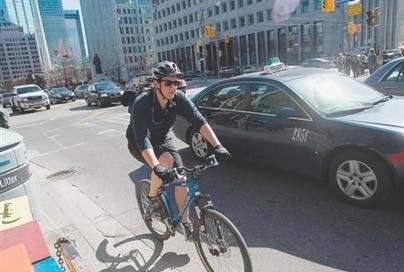
City staff wants to dedicate a lane of University Avenue to cyclists this summer, insisting it won't slow automobile traffic, as they create a denser bike network downtown.
Transportation staff is proposing bicycle lanes along University Avenue and Queen's Park Crescent.
Both roads have four lanes in each direction, with a median in between. If a pilot project is approved, one lane in each direction adjacent to the median will be dedicated to cyclists, using flexible bollards to protect them from traffic, from July to September.
"Traffic capacity analysis indicates that University Avenue could operate with three travel lanes in each direction in the peak periods with little impact on the current levels of service," a report to be debated by the public works and infrastructure committee states. The pilot project will determine if that is true, said Daniel Egan, manager of pedestrian and cycling infrastructure for the city.
Cyclists have been clamouring for bike lanes that keep them safe. Many complain about cars that illegally park in the lanes, forcing them into traffic -- an issue the bollards are meant to solve.
Councillor Doug Holyday, who is often a critic of city cycling initiatives, said the downtown bike expansion would make sense "if there were thousands of bikers out there, but at this point that's not the case."
"If they want to set up bike lanes that connect and go somewhere, do it in one or two wards and let's see what happens to it," he said, adding the city is "spending a lot of money decreasing the capacity of our roads at a time we should be increasing them to avoid all of our congestion."
Mr. Egan acknowledges the opposition to the University Avenue project -- bike lanes are a contentious issue in this city, and have been a centre-piece in the mayoral race.
He said finding the right protection for a cyclist is a balancing act, because there is only so much room on Toronto's narrow grid. "People don't feel comfortable out there. I've been a cyclist for many years and I'm unfazed by downtown traffic, but a lot of people are," Mr. Egan said.
Staff is also seeking approval to paint lanes on sections of Bay Street, Lansdowne Avenue, Brunswick Avenue and Spadina Crescent that would connect to existing or proposed "sharrows," lanes that are shared between bikes and cars. New lanes are proposed for Rathburn Road, from Mimico Creek to Kipling Avenue, and York Mills Road, from Scarsdale to Lesmill Road.
Staff also wants councillors to sign off on a deal for a new public bike share program in Toronto. If approved, the 10-year agreement with Public Bike System Company would see 1,000 bikes available throughout the downtown starting next May.
The deal was supposed to be "at no cost to the city" but in the end it will "share the financial risk" by acting as a loan guarantor.
The bike company will pay for the $4.8-million capital costs and $1.3-million to run it each year. The city is also responsible for replacing any stolen or vandalized bikes in excess of 6%.
The bike share program, modelled after a popular program in Montreal and others in Europe, is meant to act as an alternative transit system, said Mr. Egan. Users who pay an annual fee can use the bikes free for 30 minutes or less.
Mr. Holyday said the bike share is "another good idea, if you have the money for it."
He said the city is in no position to be spending money on bike programs, given the sombre news delivered by senior officials last week who predicted a 12% tax hike next year if Toronto can't get a lot more support from the provincial government.
"I think it's a needless expense at this time," Mr. Holyday said.
The city's bike infrastructure budget is $4-million this year, Mr. Egan said.
From National Post.com
